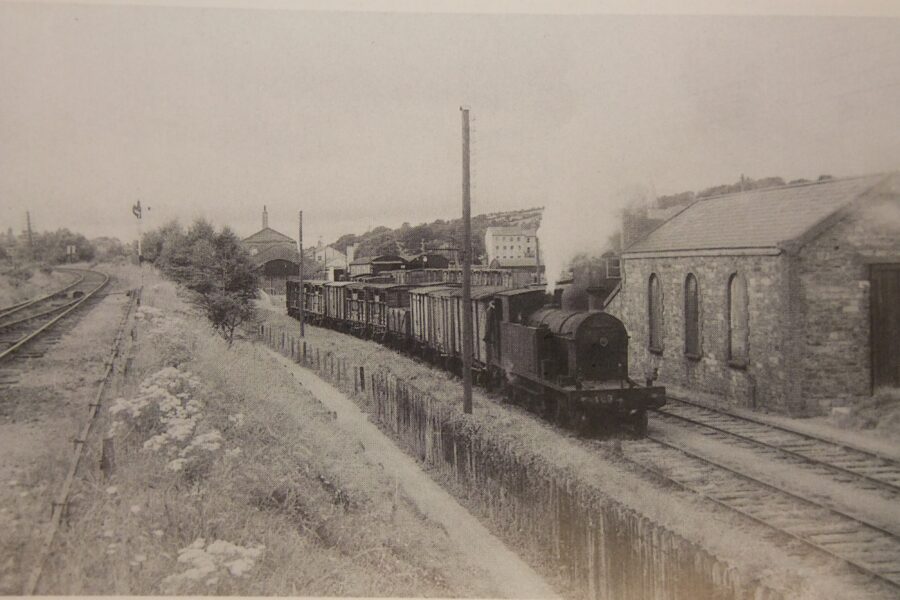
Kieran’s Our City, Our Town Article,
Cork Independent, 2 March 2023
Recasting Cork: Damages to Rail
Late February 1923 and early March 1923 coincided with AGM reports for the Great Southern and Western Railway (GSWR) Company and for the more local railway companies.
During the latter half of 1922, railway property was subject to a concentrated campaign of destruction by the anti-Treaty Republican forces. After their defeat in the Four Courts in Dublin in early July 1922 they intensified their campaign and targeted all operational railway infrastructure. The GSWR Company had a 1,800km network of which 240 miles (390 km) were double track. It was looked upon as the lines of communication of the National Army and therefore damaged with the object of preventing the movement of troops.
Numerous bridges over and under were totally or partially destroyed, signal cabins and other buildings burned down, and engines derailed. A map produced in the Dublin newspapers on 6 January 1923 showed the extent of the damage – 467 breakages in a “permanent way”, 55 overbridges damaged, 236 underbridges damaged, 3 engines destroyed, 86 engines damaged, 109 rolling stock destroyed, 260 rolling stock damaged, and a multitude of signal cabins and buildings were destroyed by fire. Approximately, a million in pounds sterling represented the losses incurred by the shareholders of Ireland’s principal railway. Claims for compensation in respect of these damages were made to the Irish Free State government.
The effects of civil war on rail traffic of the GSWR company were felt in various ways. It closed up altogether considerable sections of the line for long periods. At one time as much as 400miles of line were out of action and in early March 1923 there was a mileage of 250 miles of line on which no trains were ran. War created a general feeling of insecurity and restricted the general trade of the south and west of Ireland. The uncertainty of transit owing to constant damage to the railway temporarily turned trade to other channels. The serious delay to goods in transit reduced business. Less credit was being given. There was also a constant pillage of merchandise and trains being held up by armed forces.
The breaking of the three large viaducts in the south of Ireland practically isolated the County Cork and portion of Kerry and deprived the company of its long-distance traffic, which was the most valuable traffic they had. Passengers only travelled when absolute necessity arose. They could not rely on many parts of the line.
On 27February 1923 an AGM report for the Cork Blackrock and Passage Railway (CBPR) Company was published in the Cork Examiner. It relates that on 8 August 1922 one of the spans of the Douglas Viaduct was destroyed by explosives, and in consequence it had not been possible ever since to run any trains whatever. Such destruction hit the earning power of the line, caused unemployment for employees plus seriously inconvenienced the residents of the district.
The CBPR Company did their best to provide a substitute on the river and they took on a vessel called the Hibernia, which, jointly with the vessel called Albert, carried passengers upstream and downstream to various stations. The public were left only three days without connections with Cork and other stations. The company also put on a second goods steamer for the convenience of traders.
Furthermore, at the end of January 1923 the station buildings and signal cabins at Blackrock, Monkstown and Passage were burned to the ground by anti-Treaty Republicans, also the signal cabin at Rochestown, and, in addition, at Passage the workshops were seriously damaged and several carriages burned to cinders. The Company lamented: “At the time the train service had not been restored, and one may ask what purpose this latter act of brigandage effected? The people who will really benefit by these outrages are the bridge constructors, the carriage builders, and signal manufacturers outside Ireland. As you may readily imagine, the cost of restoration will be very heavy, so much so that unless the Government provide the money the line must remain derelict”.
On 1 March 1923, the Cork Examiner published the AGM report of the Cork Bandon and South Coast Railway (CBSCR) Company. During the War of Independence years, 1920 and 1921, damage was done from time to time to the Company’s line and many bridges were badly damaged. They were able, nevertheless, to continue working until the 9 August 1922. On that date, however, the Chetwynd Viaduct near the city was so seriously damaged by a huge explosion that it was impossible to run trains over it. Consequently, the line had to be closed for all traffic, and it remained closed for the rest of the year. The necessary stops for repairing Chetwynd Viaduct were taken as soon as protection could be obtained for the bridge repair contractors and by early 1923 trains ran again over it.
On succeeding days in August 1922 several other bridges at various parts of the Cork Bandon line were destroyed by explosives as well as other infrastructural damage.
In January 1923, ten of their stations and signal cabins were burnt down and five engines were destroyed. By early March 1923, the (CBSCR) Company was running a limited service between Cork and Bandon for passengers, goods and livestock.
Caption:
1191a. Bandon railway station, c.1920 (source: West Cork Through Time by Kieran McCarthy & Dan Breen).